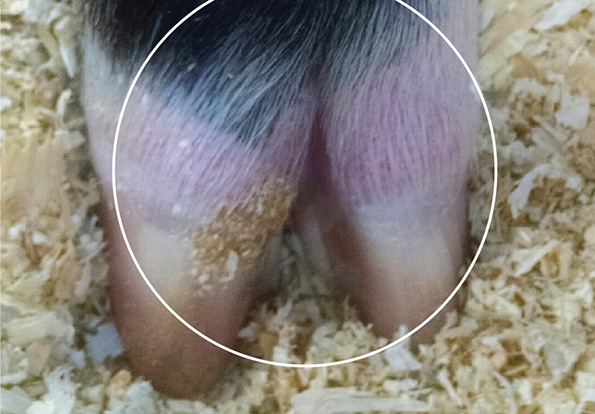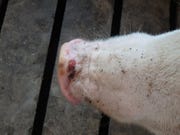More than 60 positive accessions of the Seneca Valley Virus have been reported this year by labs across the U.S., and new cases appear to be showing up more rapidly as the summer goes on.
July 22, 2016

Since January, more than 60 positive accessions of the Seneca Valley Virus, or Senecavirus A, have been reported by labs across the United States and new cases appear to be showing up more rapidly as the summer goes on. “This clearly shows that this disease is far from gone,” explains Swine Health Informational Center Executive Director Paul Sundberg. It is unknown if each accession is a new case or a continuation of an existing case. Getting more and timely information will help with analysis.
Sundberg calls for action and collaboration in the industry. “Complacency, apathy or neglect could result in terrible consequences for the U.S. pork industry. Specifically, it is critical to report all cases of vesicular lesions, suspect coronary banding and interdigital lesions to state or federal animal health officials.”
The biggest concern regarding SVV is that when clinical signs are present, they are indistinguishable from those of swine vesicular disease, vesicular stomatitis virus and foot-and-mouth disease virus. SVV does belong to the same family as FMDV, and both of these viruses can exhibit erosions, ulcerations, vesicular lesions of the snout, in the mouth, and in the interdigital space between the toes or around the top of the hoof. Lameness could be the presenting clinical sign for SVV, but fever, lethargy and anorexia may also be present. In some cases, SVV is identified by lifting the leg to carefully examine the space between the toes to look for these lesions.
SHIC funded research helps industry decide what actions to take
The Swine Health Information Center has funded about $270,000 in research related to SVV post emergence. This research is reported in detail at www.swinehealth.org/results.
One result of this research is finding variation of clinical signs among affected herds. According to a study by Derald Holtkamp and team from Iowa State University, signs observed in piglets ranged from lethargy and ill thrift to increased pre-weaning mortality and diarrhea. In sows, clinical signs ranged from the more traditional snout and foot lesions to lameness and anorexia. In addition, Holtkamp’s research reported that “common suspected risk factors for affected farms evaluated were related to entry of non-on-farm employees, carcass disposal, cull sow removal and entry of breeding replacements.”
According to SHIC-funded research by Sagar Goyal, professor at the University of Minnesota College of Veterinary Medicine, disinfectant studies have shown that 5% household bleach at the 1:20 dilution may be the most effective disinfectant against SVV working best at 15 minutes of contact time. Synergize also worked, but needed 60 minutes of contact time. Notably, Tektrol was not effective in this study.
Additional research was completed on shedding to help guide practitioner decisions. ISU Swine Extension Veterinarian and Senior Clinician Chris Rademacher reports, “We could detect the genetic material out to 42 days in low levels in tonsils and feces, but we could only detect infectious virus out to 14 to 21 days in a small percentage of the animals. This most likely means that infectious Senecavirus is probably only shed for two to three weeks after an outbreak.”
Regarding elimination, practitioners like Laura Bruner from Swine Vet Center in Minnesota and others have reported moderate control success with feedback and farm closure techniques. But as Bruner says, “Opening the farm to gilt replacements will be the true test and we’ll have more knowledge regarding the success of our applied strategies after that occurs.”
SHIC-supported webinars on targeted research have provided a means to share information regarding what has worked and where we still need more information. Listen to these webinars at www.swinehealth.org/seneca-valley-virus-summary.
What do you do if you see it? Know the plan, follow proper protocols
The USDA has issued a guidance document, Recommendations for Swine with Potential Vesicular Disease, that provides a good description of their plan to properly handle foreign animal disease investigations where information suggests that SVV may be present. The document also informs FAD investigators that duplicate samples may be taken when appropriate with the intention of sending one sample to National Animal Health Laboratory Network Veterinary Diagnostic Lab and one sample to the Foreign Animal Disease Diagnostic Laboratory on Plum Island, N.Y. State or federal animal health officials may then have the option to use the clinical presentation and the NAHLN diagnostic test results to make decisions regarding the movement of pigs. However, the USDA lab on Plum Island maintains the ability to confirm an official negative FMD test.
“As you know, state animal health officials are charged with the health and well-being of animals in their respective states,” says Sundberg. “Sometimes, SAHOs may be able to release pigs for movement based on negative FMD results from a NAHLN VDL as they wait for confirmation from Plum Island. Other times, pig movement may require the Plum Island confirmation test before the pigs in questions can be released.”
“In addition, sporadic cases of pigs or sows with vesicles continue to show up at packing plants. This is a problem because U.S. packing plants must maintain constant animal processing rates. Vesicular lesions in pigs or sows ready for marketing should be investigated, and, if possible, the lesions should be allowed to resolve before shipping. If that is not possible, communications between the packing plant, state animal health officials and USDA is essential,” emphasizes Sundberg.
At the end of the day, proper communication before shipping prevents disruption to the producer and the production plant. In Sundberg’s words, “This is another action point for us in the industry. If lesions are found, we must know the plan and follow proper protocol, it makes things easier and safer for all parties.”
For more information, visit www.swinehealth.org or contact Sundberg.
You May Also Like



